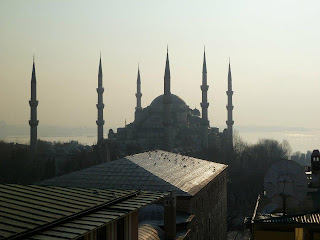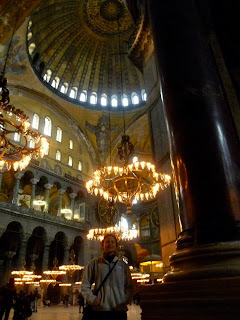The first thing we did every morning in Istanbul was enjoy the breakfast buffet at our hotel. It was quite a spread, with several hot dishes, soup, lots of cheeses and cold cuts, vegetables, fruits, cereals and breads. My favorite things were the cherry juice, which I'd never had before, and the simit. Simit is a Turkish food usually sold on the street, and it looks and tastes very similar to a sesame seed bagel.
The best part of breakfast wasn't the food, but the view! The buffet was served in the hotel restaurant on the top floor. There were huge glass windows overlooking the Blue Mosque and the Hagia Sophia. It kept getting better and better every day, as the weather got progressively sunnier throughout our trip. We lingered quite a long time at the breakfast the first morning, and didn't head out until about 11. Our first destination was the Hagia Sophia.
 |
View of the Blue Mosque from the Hotel Restaurant
|
 |
| Standing on the Hotel Restaurant balcony. Hagia Sophia in the background. |
The Hagia Sophia was originally a church built in the 4th century, later a mosque, and finally a museum. It is an immense structure, and famous for its massive dome. Its size is breathtaking, and impossible to represent in pictures. (Ross could barely get a picture of me on the ground floor and still capture part of the ceiling.) However, to me, the most interesting thing about the Hagia Sophia was the intricacy, quantity, and diversity of the artwork inside. From the huge painted angels lining the four corners, to the Iznik tiles, to the golden mosaics, I was overwhelmed by how much there was to see. We tried to at least get a general sense of everything inside by slowly making our way around all sides of the ground floor followed by the upper gallery.
 |
On the ground floor of the Hagia Sophia
|
 |
| One of the four angels |
 |
| Iznik Tiles in the Hagia Sophia |
 |
| Ross and I in the upper gallery of the Hagia Sophia |
 |
| One of the many mosaics in the Hagia Sophia |
After exploring the Hagia Sophia, we stopped for a short coffee break. Ross and I both ordered Turkish coffee as well as some Baklava. I had never had Turkish coffee before, although I’ve had plenty of Bosnian coffee. I’ve been told that Turkish coffee and Bosnian coffee are the same, but also I’ve heard the argument that they aren’t really exactly the same. From my personal experience, Bosnian and Turkish coffee are quite similar, but Bosnian coffee is somehow a bit fluffier. Regardless, the Turkish coffee really hit the spot, and gave me just enough energy to go back into the cold (Friday was a bit chilly) and continue our sightseeing.
 |
| Enjoying Turkish Coffee and Baklava |
Next we headed down to the Topkapi Palace. I didn't know very much about Istanbul until just recently, so I hadn't even heard of the Topkapi Palace until a couple of my friends recommended that I got see it. I still cannot believe how large and beautiful it is, and how many interesting and valuable things are inside.
 |
| Entrance to the Topkapi Palace: The Sultan's Gate |
 |
| Being greeted by my new friend at the gate |
After entering the Sultan’s Gate, the Topkapi Palace is basically built around two courtyards, an outer one and an inner one. Ross and I walked around half of the outer courtyard first, and then went in. The numerous structures surrounding the inner courtyard are filled with objects that showcase the immense wealth Ottoman Sultans: elaborate clothing, swords, thrones, and jewels (including an 86 carat diamond). One of the most beautiful rooms, the “circumcision room”, didn’t contain any artifact, but was lined by extremely bright blue and green patterned tiles (Iznik tiles).
 |
| The outer courtyard of the Topkapi Palace |
 |
| Ross in the inner courtyard of the Topkapi Palace |
 |
| View of the Bosphorus from the Topkapi Palace |
 |
| The circumcision room |
 |
| Colorful tiles and paint decorating the Topkapi Palace |
We spent a long time admiring all of the exhibitions, and it was kind of cold, so I got a bit chilled. Fortunately, there is a great restaurant inside the Topkapi Palace museum, with a nice view of the Bosphorus. I warmed up with some Turkish tea, and split a plate of “mezes” with Ross. Mezes reminds me very much of Tapas, small bits of food meant to be enjoyed at a leisurely pace, usually in the late afternoon. Most of the dishes are vegetarian, including a cold mashed tomato paste, eggplant in olive oil, grape leaves stuffed with rice, and cheese. So, I ate well in Istanbul. J
We finished up exploring the Topkapi Palace late Friday afternoon, and then headed back to the hotel to relax. It was nice to be inside a nice warm building after being out all day. Because the breakfast was so good, Ross and I opted to just go up to the hotel restaurant for dinner. We admired the night view, with the Blue Mosque beautifully lit up. We also tried an alcoholic drink called “raki” for the first time. I expected raki to be like Bosnian “rakija”, a potent clear liquid that can be made of almost any kind of fruit. However, Turkish raki is served with ice water, and it “magically” turns white as soon as the water is added. (I guess there’s some interesting science behind that, but I don’t know it.) It is a bit sweet, and anise flavored. I would highly recommend it to all the black licorice fans out there. It didn’t seem quite as strong as rakija, and was all in all, a great way to unwind at the end of the day.
 |
| Raki and some pre-dinner mezes at the hotel restaurant |
 |
| Hotel Balcony at night. Hagia Sophia on the left and Blue Mosque on the right. |
Because I don’t know very much about Istanbul, the history of the Byzantine and Ottoman empires, or the Muslim religion, I learned so much on Friday’s sight-seeing expeditions. I tried to look up a little bit of information beforehand, but seeing the Hagia Sophia and the Topkapi Palace inspired me to find out even more information about their history. It sounds nerdy, but it really is so much more fun when you can visit places that “make history come alive”.

















No comments:
Post a Comment